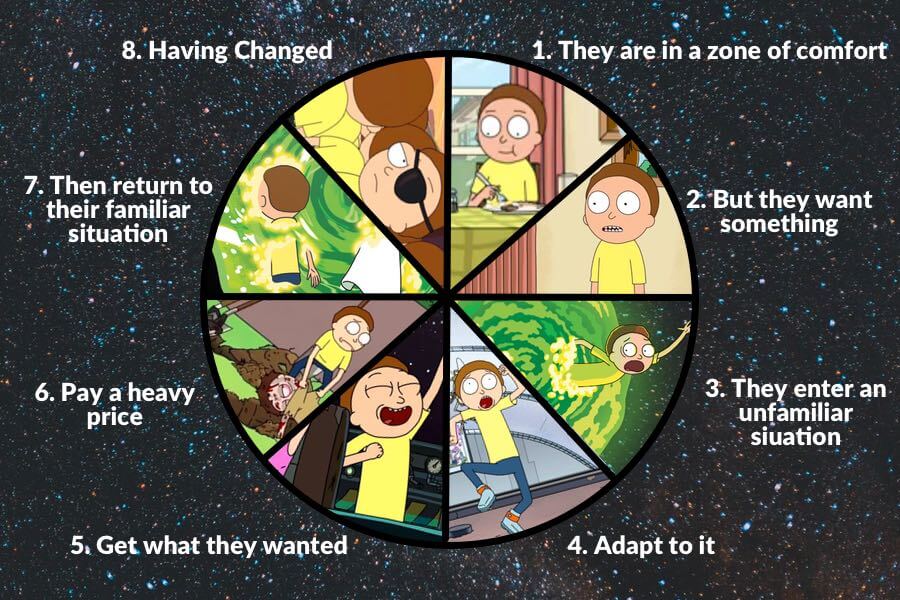Key questions to help you structure your Story
Whenever I’m faced with a new idea or concept, especially one that involves multiple steps or any sort of complexity, I find that I can grasp it far more readily if a real world example is used to explain or break it down. Dan Harmon’s story circle is a great plotting tool, and can absolutely help structure your story, but only if you really understand how to use it. Ginger first talked about that tool on this blog a couple of years ago, and since then he’s come up with a list of his own questions that drill into the concept even further. Today, he’s not only sharing those questions with us, but also applying them to a very familiar and popular example as a way to make the entire thing much easier to understand.
A couple of years ago, I wrote a post about the Story Circle – a powerful tool developed by tv-writer Dan Harmon to help authors structure their story into something readers and viewers would find satisfying.
Based on a paraphrased version of Joseph Campbell’s “The Hero’s Journey” story structure, it’s a really effective way of structuring your stories and making sure you focus on the elements that are most important. I’ve continued to use this method to great success ever since I first heard about it – but recently I tried to streamline the process even further by asking myself certain questions during my plotting and planning sessions to make identifying these key points even easier.
Because one of the questions I get asked most often is “how do you structure a story”, I thought it might be worth sharing these questions with you – and I’ll give you an example of how a story we’re all familiar with might appear if you use this method to break it down.
First off, though, I’ll share the structure of the “story circle” one more time, since it makes it much easier to understand why these questions will help structure a storyline when you look at the eight points of the circle and match different questions to specific ones.
This graphic from Reedsy.com is probably the most accessible to use to refamiliarize yourself with it (and it features Rick & Morty, too!)

Dan Harmon claims that this “story circle” is applicable to all good stories, and I’ve certainly found it to be the case. However, sometimes it’s difficult to figure out what all the eight points are – so posing these specific questions can be really valuable in streamlining that.
The Story Circle Questions
- Who is your central protagonist?
- What is the situation they are familiar with?
- What is it they NEED?
- How do they attempt to meet that need?
- What goes wrong with their attempt?
- What unfamiliar situation does that leave our protagonist in?
- How do they adapt to that situation?
- How does this adaptation allow them to get what they’d originally needed?
- How is what they’d thought they needed different to what they actually need?
- What does the protagonist have to sacrifice to get it?
- How does your protagonist return to the familiar situation?
- What has changed about your protagonist?
- How does this change affect their situation for the better?
Example: Captain America
In order to demonstrate what the answers to these questions might look like, I’m going to demonstrate by using the story of the 2011 movie Captain America, because even if you haven’t read the comic books or seen the movie, you’ll still be roughly familiar with how that story plays out.
Who is your central protagonist?
- Steve Rogers, a sickly young man with a courageous heart.
What is the situation they are familiar with?
- Steve lives in poverty in Brooklyn. He is used to being ignored by girls, picked on by bullies, and rejected because of his small size and physical weakness. However, he HATES bullies and will stand up against them even though he often gets beaten up because of it.
What is it they NEED?
- Steve wants to fight the biggest bully – Hitler – by joining the armed services and serving on the front lines of World War 2.
How do they attempt to meet that need?
- Steve uses fake names and identities in order to try and enlist even though he keeps getting rejected each and every time. Eventually, he gets given the opportunity to be the test-subject in an experiment to create a “super soldier”
What goes wrong with their attempt?
- The experiment is sabotaged and the man behind it is killed, ending the ‘super soldier’ project with Steve as its only successful result.
What unfamiliar situation does that leave our protagonist in?
- Steve Rogers is now tall, strong, and powerful – everything he wasn’t previously. As “Captain America” he is now in the unfamiliar situation of being front-and-center in the war effort, rather than completely ignored and rejected.
How do they adapt to that situation?
- Steve uses the opportunity of performing for the troops in Europe as “Captain America” to sneak behind enemy lines and rescue his best friend from a Hydra base.
How does this adaptation allow them to get what they’d originally needed?
- By proving himself in battle, Steve gets the opportunity to actually fight on the front lines of World War 2 as the real “Captain America.”
How is what they’d thought they needed different to what they actually need?
- Steve wanted to fight against the “bullies” of World War 2, but discovers that Hydra is the true power behind the German War machine and are developing the capability to kill millions and win the war through the use of alien-powered technology – meaning that the stakes are much higher than Steve had originally thought.
What does the protagonist have to sacrifice to get it?
- Steve wanted to fight against the “bullies” of World War 2. Now, in order to do that, he has to sacrifice his own life and his potential future with the woman he loves in order to prevent Hydra from destroying American cities with incredibly destructive technology.
How does your protagonist return to the familiar situation?
- Steve’s ‘super soldier’ biology helps him survive a crash that should have killed him, and he awakens in the ‘familiar’ situation of New York City.
What has changed about your protagonist?
- 70 years have passed since Steve was frozen, meaning all his friends and comrades are dead and many of the values he was fighting for have become ambiguous because of the complexities of modern warfare. He has changed from fighting against “bullies” to fighting for the “old-fashioned” values that are important to him.
How does this change affect the situation for the better?
- The “war” against Hydra is still being fought, but Steve’s commitment to his core values means that he becomes a “moral compass” in the fight against them – ensuring that he and his colleagues are the “good guys” in a world in which it’s difficult to tell who is good and who is evil.
How can this help you write better stories?
Two of the biggest problems writers face when it comes to crafting stories is either skipping the “structure” entirely and just winging it – which can result in stories that don’t deliver that satisfaction readers crave – or over-plotting it by focusing on what happens in the story, rather than the characters who make those things happen.
By asking these specific questions, you tie everything that happens in the stories to the actions of the main character – which makes it a much more intimate and believable story, and helps ensure your story develops the payoff that readers or viewers knowingly or unknowingly find satisfying.
I plan on using these questions to plan out all my stories from now on. If you try them, let me know how effective they are in the comments section below. Happy storytelling!











